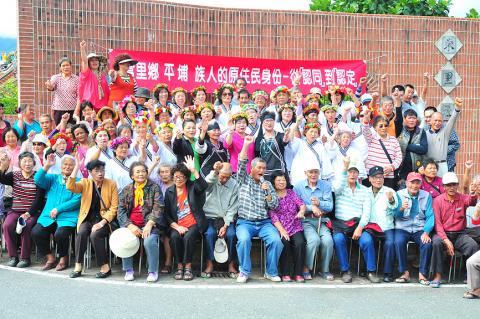|
Outcry after Pingpu expunged
ACT OF ‘EXTERMINATION’: By recognizing only the highland Aborigines, the revision to the curriculum removes the Pingpu from our history, academics say
By Tseng Wei-chen and Jason Pan / Staff reporter, with staff writer

Pingpu Aborigines in Hualien County’s Fuli Township call on the government to officially recognize their Aboriginal status on Nov. 15 last year.
File photo: Hua Meng-ching, Taipei Times
Academics and researchers have accused the government of a deliberate attempt to deny the existence of Taiwan’s lowland Pingpu Aborigines (平埔族群) in its school curriculum revision and to “exterminate” them from the nation’s history.
Wu Chun-ying (吳俊瑩), a teacher and a doctoral student at National Taiwan University’s Department of History, said on Tuesday: “The Ministry of Education essentially took out any mention of the history and culture of lowland Pingpu Aborigine groups. This is the government’s tactic to exterminate them.”
He said that the new curriculum adjustment utilizes the term yuan zhu minzu (原住民族) — which denotes “Aboriginal groups or indigenous peoples” — to replace the term yuan zhu min (原住民), which in the past was more inclusive and denoted collective groups of Aborigines.
The Ministry of Education has said the change is to conform to the terms of the Aboriginal Basic Act (原住民族基本法).
However, Wu said the government recognizes only 14 Aboriginal groups, which were mostly referred to in the past as “highland Aborigines” (高山族), denying recognition to the 10 lowland Pingpu Aborigine groups.
The 10 lowland Pingpu Aborigine groups are the Babuza, Hoanya, Ketagalan, Kaxabu, Makatao, Pazeh, Papora, Siraya, Taokoas and Tavorlong. They belong to the same Austronesian ethno-cultural family as the “highland Aborigines,” and are indigenous inhabitants of Taiwan. Their rights as indigenous people are recognized by the international community and protected in various conventions, such as the UN Declaration on the Rights of Indigenous Peoples.
“The committee members [for the curriculum adjustment] do not have a comprehensive overview of Taiwanese history. They only want to revise the texts to suit the government’s definitions of the Constitution,” Wu said.
Professor Hsueh Hua-yuan (薛化元) concurred, saying the committee members have neglected the difference between the two terms, which are contradictory, in the exclusion of lowland Pingpu groups.
Wen Chen-hua (溫振華), professor of Taiwanese history at Chang Jung Christian University in Greater Tainan, said that the Ministry of Education is applying a strict legal definition of yuan zhu minzu to replace the more inclusive term of yuan zhu min.
“It gives an incomplete picture of Taiwan’s history, and the change is inappropriate,” Wen added.
Hsiao Po-jen (蕭博仁), interim director of the Greater Tainan Government’s Ethnic Affairs Committee, said his agency has strived to gain official status for Tainan’s Siraya people for many years, but have always been refused by the central government’s Council of Indigenous Peoples.
“Now we see these changes, it contradicts the council’s stance. On the one hand, they deny the existence of lowland Pingpu groups, but on the other hand, some textbooks introduce the ‘Sinkang Manuscript’ [the Dutch translation of land leases in the Siraya language, dating from the 17th century], and mention other Taiwanese Austronesian Aborigine groups outside of the current legal definition,” Hsiao said.
“The curriculum change and its process are ludicrous,” Hsiao added.
source: Taipei Times
|